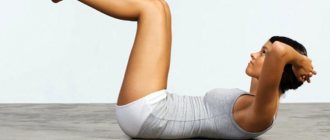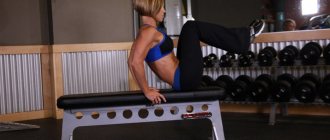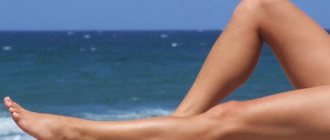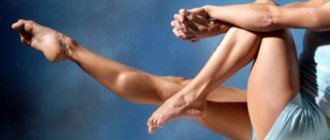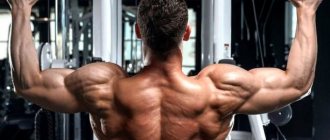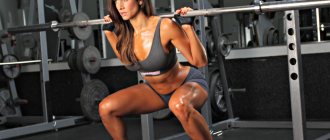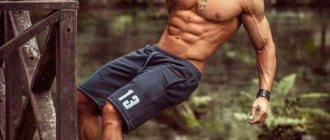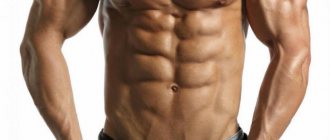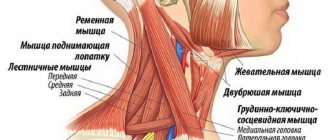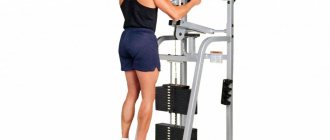It is difficult to pump up your calf muscles and make your legs beautiful, but it is quite possible. It’s difficult because the legs are accustomed to constant stress, because people walk a lot. And perhaps this becomes thanks to proven exercises that can effectively train this muscle group.
Many will be interested in learning how to pump up calves at home. For this, there are basic exercises that can be done at home. Of course, training in the gym using special equipment will be more effective. But, as they say, patience and work will grind everything down. Therefore, by paying due attention to home training, it is quite possible to achieve good results. You just need to approach your classes wisely and avoid overload. If your calf muscle hurts, then you need to reduce the intensity of your training. The muscles should feel tired, “burning”, but not pain.
Beautiful legs are needed not only by the fair half of humanity, but also by men. Nothing looks more ugly than a well-toned torso on thin and weak legs. But with well-shaped legs, the body looks simply great. And nothing will help with this more than properly organized training of the calf muscles. But before you start training, it will be useful to know how these muscles work.
Anatomy
The gastrocnemius muscle is the biceps muscle on the back of the leg. At first glance, it seems that there is only one muscle there. But that's not true. There are actually two muscles. On top is the superficial muscle, which can be seen and touched. And underneath it is a muscle called the soleus. It is the soleus muscle that provides volume. As it increases, it “inflates” the muscle located on the surface.
When walking and running, both of these muscles actively work. The reasons why the calf muscles are not developed as you would like may be the following:
- Too intense training aimed at working this muscle group.
- On the contrary, insufficient load.
- Incorrectly composed set of exercises.
You need to choose the right exercises for the calf muscles. It should be taken into account that the superficial muscle is worked in a standing position, and the soleus muscle in a sitting position. For the workout to be as effective as possible, it is necessary to load both muscles.
Don't try to achieve serious results by performing endless repetitions, such as calf raises. The main secret to pumping up your calf muscles is heavy weight training. It is recommended to train calves no more than 2 times a week.
If you have cardio training in your schedule, it is better to do it before working with iron. You should work on your calves after completing your leg workout. And you should always start by working on the soleus muscle, since it is stronger.
Exercises for pumping calves for men
We’ll tell you below how to pump up a man’s calves. All exercises are suitable for doing at home.
No. 1. Bent over calf raises
1. Place a thick book under your socks. Bend over, trying to keep your back straight. The body and legs should form a right angle.
2. Extend your arms in front of you, grasping the back of the chair. Take a half-squat position.
3. Standing on a book, transfer the entire load to your toes and stretch as high as possible. Stay at the peak for literally 2-3 seconds.
4. Then lower yourself down, touching your heels to the floor. The exercise is performed until the calves become clogged.
No. 2. Walking on your toes
1. There is nothing easier than such an exercise. You need to straighten your legs without bending your knees. Next, stand on your toes and walk around the house.
2. To increase the load, use weights. These can be water bottles or dumbbells. The main thing is not to bend your limbs at the knees.
No. 3. Classic calf raises
1. Stand up straight. Begin to rise onto your toes measuredly and without sudden movements. Then gently lower yourself onto your heels.
2. First, the legs are placed parallel to each other and pumped until they become clogged.
3. Then you can alternate positions by spreading your heels or toes. This way you can pump up all the muscles of the lower leg.
4. To complicate the task, you can arm yourself with dumbbells. In total, we recommend doing 4-5 sets of 25-30 repetitions.
No. 4. Calf raises while standing on a step
1. There are many ways to pump up a man’s calves. This version of the exercise is considered a complication of the previous one and is simply performed at home.
2. Stand with your toes on the edge of a step (step platform, book or other elevated surface). Hold onto a wall or railing with your hands.
3. Rise up onto your toes, then slowly lower down. The heel should touch the bottom step (if possible). You will feel your lower leg stretch.
4. By analogy with the previous method, it is necessary to separate the toes or heels in order to pump the calves in different places.
No. 5. Seated calf raises
1. Sit on a chair, keeping your knees together. Place a weight or a five-liter water bottle on your feet.
2. Place a thick book under your socks. Lift your heels off the floor, try to lift them high. With a load it can be difficult.
3. Then lower just as slowly until your heels touch the floor. Do the exercise 3 times for 20 repetitions.
No. 6. Walking on the steps
Since there are various ways to pump up a man’s calves, consider one more. The procedure is not carried out entirely at home.
1. Go out to the staircase or find the nearest steps. Start walking on them until you are completely tired. You should feel the muscles “clog.”
2. Try to step on every step. After that, step over one or two. Alternate these exercises with each other.
No. 7. Single leg squat (“Pistol”)
1. To start the exercise, just stand up straight and stretch your arms in front of you.
2. Perform a one-leg squat. The second should be straightened parallel to the floor. Change legs.
3. Perform 10 repetitions in 2 sets on each leg.
No. 8. Jumping with weights
1. Such a workout puts a fairly high load on the muscles. The exercise is difficult for an unprepared person to perform.
2. For weights, you can use dumbbells. Take them in your hands and sit down. Try to jump as high as possible.
3. The number of repetitions is not limited. Calculate your own strengths.
Springs
Initial position
Stand up straight, keeping your back straight.
Execution technique
Slowly rise onto your toes, trying to raise your heels as high as possible.
Then the exercise is performed with weights. To do this, simply pick up dumbbells. If it is difficult to maintain balance with two dumbbells, train with one, holding the support with the other hand.
As a more challenging version of this exercise, you can perform it by standing up alternately on one leg and then on the other. Also with weights. Perform 3-4 sets of 30 times.
Recommendations
The exercise must be performed slowly.
Calf training like an adult
To pump up your calves, you need to bomb them intensely, regularly and with complete dedication. Anyone who has trained calf muscles knows how hard and painful it is, and besides, the calf muscles grow very slowly. Of course, you can point to genetics and ignore pumping up your calves; after all, who sees them? But the truth is that these muscles are special and require a special approach. Today I want to talk about the rules of calf training, its subtleties and nuances. The most interesting things about training and sports nutrition on our telegram channel https://t.me/bestbodyblog
Introduction
Nobody likes to pump up their calves. In any case, I have never met anyone who likes to pump up their calves. I myself, to be honest, for a long time avoided training the lower leg, paying attention to other, more responsive muscle groups. But one day, looking at my legs in the mirror, I realized that the time had come, and I began to figure out why my calves weren’t growing, and how this problem could be solved? I won’t say that I have become a fan of pumping up my calves, however, I now know how to pump up my lower legs faster. But before I move on to the description of the calf training itself, I want to talk about 5 features of pumping this stubborn muscle. So…
Why is it important to pump up the soleus muscle?
The full name of this much-unloved muscle group is the triceps surae muscle. Not just the lower leg, and not the calves, but precisely the triceps surae muscle. I specifically draw attention to its name because it consists of two separate muscles - the small gastrocnemius, consisting of two heads and located on the surface, and the large soleus, which has one head and lies under the gastrocnemius muscle.
To pump up your lower leg, special attention needs to be paid to the soleus muscle.
This means that to increase the overall volume of the lower leg, it is more important to pump up the soleus muscle than the gastrocnemius. The larger it becomes, the larger the shin itself becomes. In addition, the soleus muscle, increasing in size, pushes the gastrocnemius upward, making it much more massive, especially when viewed from the front.
How to pump calves correctly?
The lower leg muscles are very strong and resilient (just like the abs, forearms and neck), during the day they contract thousands of times, while supporting the weight of our body. This means that performing calf exercises with a high number of repetitions is ineffective. This load is also needed, but it needs to be included in a set of exercises for the calves at a special stage.
To quickly pump up your calves, you need to load them in a forceful (unusual for them) style, using a weight that is 1.5-2 times your body weight. The number of repetitions should be average: 10-12. But that is not all. The time that muscles spend under load should be increased to 35-45 seconds. Therefore, you need to perform the exercises very slowly.
Why do calves hurt and why is this important to us?
Calves hurt because they are made primarily of slow-twitch muscle fibers. These fibers are weaker and thinner than their fast counterparts, but are able to contract with the same intensity for a very long time. A by-product of such long-term work is lactic acid; it is formed in the muscles as oxygen deficiency increases. Lactic acid causes pain in the calves, being the scourge of all athletes (runners, walkers, cyclists) who perform physical exercise over long periods of time.
Calves hurt because lactic acid accumulates in them
Average people experience pain in their calves after a long day on their feet. Especially if you had to walk, stand or climb stairs a lot. Such pain is a kind of bell with which the body calls us to stop. But not in our case, because when it comes to training the calves, the situation is different.
The burning sensation is not a signal to stop doing the exercise, but an important moment to begin serious work. Lactic acid, causing a burning sensation in the muscles, simultaneously stimulates an increase in anabolic hormones responsible for their growth. The ability to step beyond the pain threshold and continue to pump calves, despite the pain, is one of the main conditions for increasing their volume. However, when pumping the calf muscles in a power style, it is not possible to achieve oxygen deficiency; the calf muscles work, but a burning sensation does not appear.
Calf workout for masochists
But muscle pain appears during partial repetitions. This means that after performing repetitions at full amplitude, you need to do a few more movements in a shortened manner until failure. In the symbiosis of heavy power load and light (but very painful!) pumping load lies the key to accelerated growth of the calves.
On the subject: What exercises tighten your legs
Note: Arnold Schwarzenegger was famous not only for his chest and biceps, but also for his magnificent calf muscles. Moreover, he managed to pump up his calves quite quickly. One of his secrets for pumping up the calf muscles was that when performing calf exercises, he began to count repetitions only after a strong burning sensation appeared in the muscles. If pain appears in the calves, then it’s time to work, so he said.
Calf stretch
Stretching the muscles when pumping the calves is very important. But in everything you need to know when to stop. The function of the calf muscles is to flex the foot, lift the toe and turn the foot to the side. But when lowering the foot down, the lower leg does not work. This movement occurs due to stretching of the Achilles tendon. There is no particular point in going down very deep, 3-4 cm is quite enough. And then only in order to be able to rise on your toes 2-3 more times with the help of inertia. Moreover, if the weight of the load is large, low and sudden drop of the foot can cause injury. It is necessary to descend to the lowest point of the trajectory, stretching the lower leg very smoothly.
Calf stretch against the wall
At the same time, stretching the calf muscles, as well as warming up the ankle joint, is a mandatory element of warming up this muscle group before starting the exercises. The purpose of such movements is to prepare joints, ligaments, and tendons for the upcoming hard work. You also need to end your calf workout with stretching. It will reduce pain and speed up recovery.
How often to pump calves?
If desired, at least every day. They are very hardy, so they recover quickly. But pumping calves and pumping up are two huge differences. First, any muscle group needs to be given time to rest and grow. And secondly, the main factor in muscle hypertrophy is stress load. If you pump your calves often and in exactly the same way, they will not grow. They will become stronger and more prominent, but their volume will not increase. The best option is to pump your calves twice a week (for example, Monday and Friday), but do it a little differently each time.
Frequently pumping the shin is the lot of professionals
Professionals have their own opinion on this matter; they unanimously insist that you need to pump your calves every session, this way you can add volume to them much faster. And here they are absolutely right, but with only one caveat: the benefits from frequent pumping of the lower leg muscles (as well as other muscles) can only be obtained against the background of the use of pharmacological support. In natural bodybuilding, everything is much more complicated; thoughtless loading of your body, against the backdrop of overtraining, always gives the opposite result.
How to pump up calves at home?
Pumping up calves at home is not that difficult, at least not more difficult than in the gym. The main feature of home training is a narrow arsenal of exercises, but by and large, ordinary dumbbells are quite enough to pump up the calves. Exercise No. 1 for home is calf raises with one dumbbell. But what about the soleus muscle, since it is of priority importance for the development of the lower leg? There is a home exercise for her - sitting up on your toes with dumbbells. In terms of their biomechanics, such lifts are a complete copy of the lifts in the simulator, and before their appearance, the soleus muscle was pumped exactly like this - they put dumbbells on their knees (or put a barbell) and raised their legs on their toes with emphasis on the platform.
Seated calf raise with dumbbells
What if you want to pump up your calves at home but don’t have dumbbells? Their replacement will be the usual, well, not quite ordinary, walking up the steps. It’s not ordinary in the sense that you need to climb the step with each foot by placing it on the toe, and not on the entire foot, and at the same time transfer the weight of the entire body to the supporting leg. If climbing stairs does not seem like a serious way to pump up your lower legs, it can be easily complicated - a heavy backpack put on your back will instantly change any person’s idea of this exercise.
Walking up the stairs is a good way to tone your calves at home.
This method of training the calves is so effective that you can safely include it in your training complex even if you have dumbbells at home. In this case, walking up the stairs will become a “finishing” exercise and will help move the volume of this “stubborn” muscle group. Walking up the stairs has one more advantage - it is a very energy-consuming exercise, so it can be regarded as a home alternative to cardio.
A calf training complex at home might look like this:
| Exercise | Approaches | Repetitions |
| Seated calf raise with dumbbells | 5 | 7-9 |
| Standing calf raise with dumbbell | 4 | 8-10 |
| Walking on the steps | 3 | 40-50 |
How to pump up a girl's calves?
Calf training for girls has its own characteristics, since men need, first of all, large and wide shins to match their quadriceps, and women need them to be slender and sculpted. Therefore, approaches to the development of this muscle group differ between representatives of both sexes.
- Girls should not particularly pump up the soleus muscle, that is, perform calf raises while sitting, because this makes the calves wider when viewed from the front.
- A woman should perform exercises for the lower leg not in a strength-based manner, but in a multi-repetition style, that is, do 15-20 repetitions per approach.
Of course, this style of performing the exercise on the calves will not add serious volume, but it will quickly improve their shape and detail. The remaining rules for pumping the lower leg: stretching and frequency of loading must be strictly observed.
A calf routine for girls could be like this:
Note: The easiest way to improve your calf shape is by jumping rope. Three sets of 25-30 jumps with a break between them of 30-45 seconds will help you quickly improve the shape of your calves without any additional exercises.
Exercises with step platform
If there is no platform, you can perform these exercises on a step.
Initial position
Stand with your toes on the edge of the platform or on a step. Keep your back straight.
Execution technique
Rise on tiptoes as high as possible. Lower your heels as much as possible, significantly stretching your ankle. You can take a dumbbell in your hand, resting your other hand on the wall.
Recommendations
Alternate the position of your legs, keeping your feet parallel, moving your heels or spreading your toes. This will help work different parts of the calf muscle. With the feet parallel, the middle part is worked, with the heels shifted, the inner surface of the muscle is worked. If the toes are shifted, then the main load falls on the outer surface.
Exercises for the calf muscles
In order for training to be effective, you need to create the right schedule. If you need results very quickly, you will have to devote at least half an hour to this muscle group every day. But it’s better to start exercising every other day so that your legs get used to the load.
Don't be afraid that your calves will become too pumped up. Firstly, you can always stop as soon as the required form appears. Secondly, pumped calves occur as a result of serious physical exertion along with taking special medications. Regular exercises will not have this effect.
Exercise No. 1
The most effective exercise for quickly getting your calves back to normal is squats. The main thing is that the feet do not come off the floor, the thighs are parallel to the floor, and the back is straight. Then, when performing the exercise, the calf muscles will receive the load they need.
At first, it is enough to do 20-30 squats per workout. Then you gradually need to increase this number to 100–120 squats. Squats with dumbbells give good results.
Exercise No. 2
This exercise can be done while sitting. You need to place a load weighing 1–2 kilograms on your knees. You can take a few books or even do the exercise with a small child in your arms. While sitting, you need to start raising your feet on your toes.
If after 10 repetitions you feel like your calves are “burning,” then the exercise is effective. It is important to do everything slowly and not overdo it. It’s better to start with 15 repetitions and increase them, depending on your own well-being. It is better not to put a lot of stress on your legs right away. This exercise helps pump up the soleus muscle.
Exercise #3
The previous exercise can be done from a standing position. In gyms it is done using special devices. But having dumbbells at home is enough. Your back should be straight while lifting on your toes. You need to start doing the exercise with a small number of repetitions, and then increase the load.
Exercise #4
To perform this exercise, you need to lie on your back and raise your legs up. The arms should lie parallel to the body. Socks should remain loose. Next, you need to stretch your toes up with all your might. You can remain in this position for a few seconds. Then relax the muscles, but do not lower your legs. To begin with, it is enough to do the exercise 10–15 times.
Exercise #5
Jumping from a squat with a load gives a good load on the calf muscles. To do this, you need to take dumbbells and try to jump forward as high as possible. To begin with, 15–20 repetitions are enough.
Exercise #6
For this exercise you will need a step platform. If you don't have one, you can use a thick book. A step will also work. The exercise is performed as follows - you need to stand on an elevated platform with your toes and gradually rise onto your tiptoes.
Then you should also slowly begin to lower down, stretching your ankle well. It is advisable that the heels touch the floor at the end.
If you keep your feet parallel to each other during the exercise, the middle part of the muscles will be pumped. If you place your heels together and your toes apart, the main load will be directed to the inner part of the muscles. The “toes together, toes apart” position pumps the outer parts of the calf muscles.
Seated calf raise
Initial position
- Sit on the exercise machine seat.
- Place the toes of your feet on the supporting step.
- Lower your heels towards the floor as much as possible.
- Lower the lever with soft stops onto your knees and lock it.
Execution technique
Raise your socks as high as possible. Pause in the final position.
Recommendations
Before each repetition, pay attention to stretching the soleus muscle.
How to pump up a man’s calves – warm-up before training
It is important to understand that any impact on the lower limbs is traumatic. Some exercises put a lot of stress on your joints, so warm up beforehand:
- roll your feet onto the inner and outer edges alternately;
- squeeze, spread, strain your toes;
- pull the sock, then pull it towards you, straining your calves;
- alternately rotate your ankle while standing on your toes;
- Squat down with your buttocks pushed back (so that your knees don’t go over your toes);
- lying on your back, lift and stretch your leg, begin to bend/extend your knee;
- relax and jog your legs while standing;
- grab your leg with your hand, shake the relaxed shin;
- stand facing the wall, take your leg back, stick out your toe, then pull it towards you;
- in a standing position, place your palms on your knees, make circular movements with your knee joints (inward, outward);
- in a half-squat, connect your legs, first rotate them to the right, then to the left;
- stand with your hands on your waist and rotate your pelvis.
Do your warm-up at your own pace. The main thing is to carefully work out the knee joints, ankles, toes, and hip joints.
Standing calf raises
We have already looked at standing calf raises, which can be done at home by holding dumbbells in your hands. Here is the same lift, only using a simulator.
Initial position
- Stand with your toes on the support step of the machine.
- Place your shoulders under the movable supports.
- Lower your heels as much as possible.
- You should feel tension in your calf muscles.
Execution technique
Rise up onto your toes as high as possible.
Recommendations
In the final position there should be a pause.
